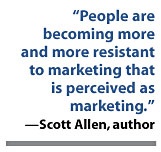May 2006 - Do You Blog?

A closer look at how direct marketers can form an online dialogue with prospective and existing customers.
By David Lustig
Probably the scariest words in the English language are those that we are not sure of their meaning. The word blog is a perfect example. Shortened from weblog, for our purposes, it is a place on the Internet where people can go to and see what is happening with a particular company. Usually authored by a designated employee of that company, it is not there to sell you anything. Rather, in its best form, a blog is a place where two-way dialogue between someone from the company and the people interested in its products and trends can talk.
Look at a blog as an online journal of day-to-day events, explains Harish Keshwani of Ideologic LLC, a web design and blog consulting company in Omaha, Neb.
“This online journal is available in the form of a web page for anyone to view,” he says. An individual entry in a blog is called a blog “post.” Each post has comments from readers, which sometimes morphs into a discussion between the blogger and readers of the blog.
But instead of trying to explain it further, let’s look at a blog that, while not about direct marketing, is of broad enough interest to appeal to most of us: one on automobiles. An example would be the General Motors blog at http://fastlane.gmblogs.com. Here you will find GM Vice Chairman Bob Lutz letting automobile buffs know about things General Motors is doing. He’s not selling, mind you, but letting everyone know what’s happened at a recent car show, or asking car owners-and not just GM car owners-what they would like to see on cars in the future. The questions are varied, but are crafted to stay on the general topic of the blog.
 Blogs are different from forums or newsgroups in that only the creator/owner can create new subjects to discuss, keeping it on track and preventing discussions from getting hijacked. Blogs are also easier to post to than a traditional web site or chat room, with automated templates taking care of new entries.
Blogs are different from forums or newsgroups in that only the creator/owner can create new subjects to discuss, keeping it on track and preventing discussions from getting hijacked. Blogs are also easier to post to than a traditional web site or chat room, with automated templates taking care of new entries.
But how does this apply to, or be of help to, direct marketing?
BLOG TECHNOLOGY CAN HELP CUSTOMER RESISTANCE
“There is a trend in the marketing/ advertising industry that some are reluctant to talk about,” says Scott Allen of Austin, Texas, co-author of The Virtual Handshake: Opening Doors and Closing Deals Online. “People are becoming more and more resistant to marketing that is perceived as marketing.
“We’ve gotten to the point that we are bombarded by more and more marketing messages every day. There is a resistance as we become more high tech. It’s not that we need the physical contact, but we need to feel we’re not being treated as a number.”
Des Walsh, author of the 7 Step Business Blog, explains that blogging enables prospects to discover the benefits of a business’ products or services. It can be many things, he says, including demonstrating “thought leadership” in a crowded market, differentiating your business and/or service from the rest, the ability to get direct feedback, product improvement suggestions and good news stories from the customer base, as well as early warnings of problems. Walsh, who is a business coach and “blogging evangelist,” resides on Australia’s Gold Coast.
 Harish Keshwani says that direct marketers who have already realized the potential of blogs are using it daily and building an advertising campaign that will have a lasting positive impact on product sales.
Harish Keshwani says that direct marketers who have already realized the potential of blogs are using it daily and building an advertising campaign that will have a lasting positive impact on product sales.
“They are thinking about ROI,” Keshwani says, “but this ROI is not based on a conventional marketing compaign. It is based on how many potential customers will convert to confirmed customers after searching and finding the information they want about a product or service from the blog contents of the company.”
One example of a brand name company that has effectively used blogs to enhance its marketing efforts is Ford Motor Company’s Mustang Blog. Although it’s also automobile related, Keshwani says it’s even more focused than the GM blog. “The Ford Mustang team writes this blog about finer and/or little known features of the Mustang automobile. People who are considering buying a Mustang get in-depth information about the product from Ford’s technical teams. This is a great selling point,” he says.
Many companies have more than one blog tied to their traditional web site.
“One blog can be closely tied to your company, the other is an interest blog that will provide compelling content that will keep people in your target demographics engaged,” says Allen.
MISCONCEPTIONS
One misconception, says Walsh, is that some people think blogs are a fad. They’re not. Another is that you might get negative feedback. Negative feedback can be a plus, he says, because it is often the truth that otherwise you might not hear until it’s too late.
Other bugaboos include the notion that it’s too expensive-nonesense he says-and that you have to be a great writer to have an effective blog.
“The fact is,” says Walsh, “is that if you can write an e-mail, you can have an interesting and attractive blog.” Nor, he says, does a blog have to be technically complicated.
Keshwani brings up other misconceptions.
“Direct marketers are used to an ‘almost instant ROI,’” says Keshwani, “whereas blogs have some waiting period before there is any ROI. The most common misconception is to expect ROI too early in the game. When product information, tips and tricks, little known features of a product are posted daily in a blog over a long period of time, one can expect a steady inflow of traffic to the web site, thus increase the changes of a better ROI.”
Allen says another is that blogs are overblown diaries on steroids.
“They are a major new medium,” he says, “the only way to describe it is they are like radio, TV and print. Blogs are another medium and it’s got its own set of unwritten rules.”
 While blogs are quite popular in the technology sector, Allen says in the direct marketing industry, “we are right at that critical crossing of the chasm point.”
While blogs are quite popular in the technology sector, Allen says in the direct marketing industry, “we are right at that critical crossing of the chasm point.”
“The most important point to make here is that we are far enough along to see it [blogs] as an upward trend,” he says, “but early enough that people who move on it now still can get a significant competitive advantage.”
WILL BLOGS REDEFINE THE INDUSTRY?
“It’s already redefining how business is done,” explains Walsh. “I have no crystal ball, but 10 years ago, I tried to interest businesses in having a web site and was told it was too expensive, too risky and too complicated. I was told I’m not ‘a techie’ and it’s a fad. If any of those businesses don’t have a web site now, it’s probably because they are not in business any longer.
“So ask me the same question about blogs in 10 years, no, make that five. I think I’ll be smiling then, too.”
“Direct marketing in its current form and in the form of a blog will co-exist,” says Keshwani. “Blogs will have a special place in the world of direct marketing. E-mails and RSS feeds will continue to dominate [and] influence DR, and blogging will be another source of marketing. It will be a good fit, especially due to the longevity of the campaign this type of marketing has with the search engine advantage.”
WHY SHOULD WE PAY ATTENTION TO BLOGS?
It should be apparent by now that there are millions of Internet visitors using blogs and because of those numbers, as a direct marketer, you should pay attention to what is out there.
“Conventional direct marketing has an ROI per advertising campaign, whereas a blog continues to receive a steady stream of traffic from search engines long after a blog post is published,” continues Keshwani. “This is significant as the impact of the blog is everlasting because the ‘written word’ is always there on the blog and is indexed by the search engines to be presented to potential clients who are searching for a product or service. Direct marketers, while continuing to use conventional methods, must explore blogs to reap the benefits and gradually reduce conventional marketing methods.”
Walsh adds, “It’s relevant that in blogs you can get a lot of unfiltered information about what is really happening with the web and about how the web and web tools are being used in marketing.
“Before I buy any new software product or communications technology, I am likely to go online and type in the name of the product and the word blog. This usually brings up a number of blogs.”
TIPS FOR USING A BLOG EFFECTIVELY
“You have to blog at least once a week,” says Allen to those who want to have a blog as part of their web presence. “Some people do it daily or multiple times a day. And it depends if you’re writing one paragraph posts, using it as a link to something else or if you’re writing mini-articles. Some blogs work better with one or the other, some are successful using a mix.”
According to Keshwani, “The key is to provide something of value to the readers. Use both direct marketing and blog marketing for a certain period of time. Once blog marketing starts giving substantial returns, conventional direct marketing may be phased out.”
Walsh sums up his advice on blogging simply, “If you are not prepared to be honest and use your own voice, rather than just reproducing something from a brochure, it is probably not worth your while. But do put some time into watching what your competitors are doing in the space.
“If you have any interest in life outside your product line, whether the interest is in rare stamps, skydiving, travel to exotic places, bringing up children or watching old movies, and you are happy to write about that, you can create a blog that will probaby get more traffic and more customers than if you just have a variation on a company web site.”
David Lustig is a contributing writer to Electronic Retailer. We would appreciate your feedback. To submit comments, please e-mail the magazine at [email protected].